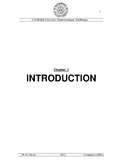Please use this identifier to cite or link to this item:
http://archive.nnl.gov.np:8080/handle/123456789/173| Title: | A STUDY OF VAT IN INDIAN TAX SYSTEM- AN EVALUATION |
| Authors: | Chaudhary, Jagnnath |
| Keywords: | VAT in Indian Tax system |
| Issue Date: | 24-Mar-2019 |
| Abstract: | The present study describes the various aspects of VAT in Indian Tax system. The main purpose of the research is to examine the implications of VAT on streamlining Tax System in India with special reference to commercial taxes in Bihar. The theme will mainly cover the implications of VAT on streamlining Tax System in India in the light of the changing global scenerio and further it will discuss its impact on the changing age of commercial Taxes in Bihar. The objective of research is to evaluate the implications of VAT on streamlining and restructuring of the Tax System in India and specially in Bihar in the broader light of the role of commercial taxes in Bihar since tis emergence to the age of VAT. It will also discuss the suggestions to combact the drawbacks and to stabilize the Value Added Tax System and will further explore the pavement for its smooth functioning. This reserch was secondary sources data. The basic reserch design used the data gathered form official report books related with value added Tax, research journals and surveys undertaken by different authorities. Lastes data and the analysis there of along with statiscial tables, charts and fiugre had been used for drawring conclusion and making recommendation. The various kinds of Indirect taxes and duties levied in India, at the state and Central level are illustrated hereunder: Both the Customs and Excise duties are levied and collected by the Central Government. While the Customs duties are levied, collected and retained by the Central Government, the Excise duties are shared by the Central Government with the State Governments. The State sales tax is levied and collected by the states on all intra state transactions. Central Sales Tax is levied by the Central Government and collected by the states and such levy is restricted to interstate sales originating in the concerned state. The former is regulated by the concerned State Sales Tax Act, while the Central Sales Tax is regulated by the Central Sales Tax Act, 1956.4 In the budget for 2003, the Finance Minister of India, after various rounds of consultation with the states of India, proposed the introduction of VAT in India on a nationwide basis, replacing the State Sales Tax Act (India has 28 states and each state has enacted on sales tax). Broadly stated are the key features of VAT to be introduced in India: VAT proposed to be introduced in India is a simple and a transparent tax collected on the sale of goods. VAT is to be consumption based and applied on destination principle5. Under the consumption type VAT, the base excludes the value of both intermediate inputs and investment items from the gross value of goods and services. The base—as defined—is close to the one in retail sales taxation. VAT computation is to be based on the invoice-based credit method. Under this method, a firm at any stage of the production-distribution chain charges its customers the VAT on its output, submits the tax to the treasury, and then claims for the VAT already paid on its input purchase. The emphasis placed on each transaction means that the evidence for each sale or purchase, the invoice, becomes a crucial document to monitor and administer the VAT.6 Thus, the burden of VAT is not borne by producers or suppliers of taxable goods or services, but rather by the ultimate consumers thereof. Who is covered by VAT? All business transactions carried on with a state by individuals, partnerships, companies etc. will be covered by VAT. VAT will not cover small businesses with a turnover below a certain limit which will be decided by each state. The turnover limit for eligibility of retailers to opt for payment of tax at compounded rate of tax may be Rs 20-50 lakh (USD 40,000 to 80,000) as may be specified by the respective states.5 All retail dealers9 with annual turnover above the limit specified will have to pay VAT even if their entire business is in retail. Retail dealers below a threshold limit of annual turnover, as may be specified in the respective State VAT legislation, may opt for payment of tax at a flat rate of 1-2 per cent. The terminology is not uniform in all the States. Presumptive tax, turnover tax or composition of tax has been used to describe the levy of tax on retailers. The `sales' not liable to tax under the VAT Act: Since the VAT Act applies only to sales within a State, the following sales shall not be governed by the VAT Act: a) sale in the course of inter-state trade or commerce which shall continue to be liable to tax under the Central Sales Tax Act, 1956; b)7 sale which takes place outside the state; and c) sales in the course of export or import. |
| URI: | http://103.69.125.248:8080/xmlui/handle/123456789/173 |
| Appears in Collections: | 300 Social sciences |
Files in This Item:
| File | Description | Size | Format | |
|---|---|---|---|---|
| table Content.pdf | 274.79 kB | Adobe PDF |  View/Open | |
| ABSTRACT.pdf | 246.56 kB | Adobe PDF |  View/Open | |
| Supervision Certificate. .pdf | 363.99 kB | Adobe PDF |  View/Open | |
| Chapter 1- 7.pdf | 1.79 MB | Adobe PDF |  View/Open | |
| 1_Supervision Certificate. .pdf | 363.99 kB | Adobe PDF |  View/Open |
Items in DSpace are protected by copyright, with all rights reserved, unless otherwise indicated.